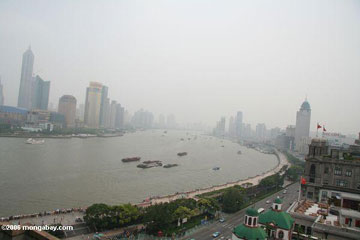Chinese traffic restrictions rapidly result in cleaner air
Chinese traffic restrictions rapidly result in cleaner air
American Geophysical Union
April 30, 2007
Chinese government restrictions on motorists during a three- day conference last fall cut Beijing’s emissions of an important class of atmospheric pollutants by up to 40 percent, recent satellite observations indicate. The November restrictions are widely viewed as a dress rehearsal for efforts by the city to slash smog and airborne contaminants when China hosts the 2008 Summer Olympic Games.
The restrictions on Beijing drivers coincided with a summit meeting on China- Africa cooperation from Nov. 4-6, 2006, during which an estimated 800,000 of Beijing’s 2.82 million vehicles were taken off the road. Researchers now have used measurements taken from space to evaluate Beijing’s air quality before, during and after the conference.
“Traffic restrictions implemented during the Sino-African Summit were remarkably successful in reducing emissions of NOx,” report Yuxuan Wang of Harvard University and her colleagues. NOx is a class of nitrogen oxides formed during combustion and thought to contribute to global warming. The research team assessed Beijing’s emissions using data from the Dutch-Finnish Ozone Monitoring Instrument aboard NASA’s Aura satellite, which was launched in 2004.
“We expected a drop in nitrogen emissions, but not to this extent, and after only a short period of time,” Wang adds. She conducted the study with colleagues at Harvard and at the Royal Netherlands Meteorological Institute in De Bilt, Netherlands. The scientists presented their findings April 28 in Geophysical Research Letters, a journal of the American Geophysical Union.
 Shanghai. Related articles Asian pollution contributes to California warming. Pollution from Asia may cause warmer spring temperatures on the West Coast of the United States according to a new study led by scientists at the Scripps Institution of Oceanography, at the University of California San Diego. The researchers estimate that Asia may generate as much as 75 percent of black carbon, a type of particulate pollution that impacts atmospheric temperatures by absorbing sunlight and reducing surface radiation. Overall, say the researchers, black carbon has a net warming effect on local climate. China may top U.S. in greenhouse gas emissions in 2007. |
Past satellite studies by other researchers have detected a “weekend effect”– reduced NOx emissions on weekends compared to weekdays–over cities and industrial areas in the Europe, Japan, and the U.S.
China is the world’s second largest producer of greenhouse gases behind the United States and a major source of atmospheric NOx. Last November’s driving restrictions in Beijing ranged from regulating access to specific roads to restricting use of both private and government vehicles.
The size of the resulting NOx reduction surprised Wang and her colleagues in part because it departs from recent estimates. Those say that during non-heating seasons, nearly 70 percent of NOx emissions in the Beijing area are from vehicular emissions. Using this as a standard, the team calculated that there would need to be a 50 percent cut in vehicular use in Beijing to account for the observed 40 percent drop in NOx. This stands in contrast to the reported traffic decrease of nearly 30 percent. “We’re not sure what this means, and there will definitely need to be more detailed data on vehicle energy usage, like gasoline sales data, to develop a more precise value,” Wang says.
Traffic cutbacks expected this summer as practice for the Olympics, as well as restrictions during the games themselves, will offer opportunities for further study of the processes determining the quality of air over Beijing, she adds.
Citation: Wang, Y., M. B. McElroy, K. F. Boersma, H. J. Eskes, and J. P. Veefkind (2007), Traffic
restrictions associated with the Sino-African summit: Reductions of NOx detected from space,
Geophys. Res. Lett., 34, L08814, doi:10.1029/2007GL029326.
The text of this article is a modified news release from American Geophysical Union.